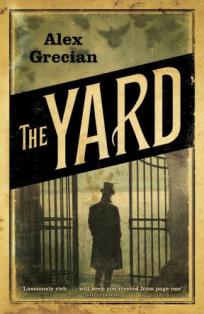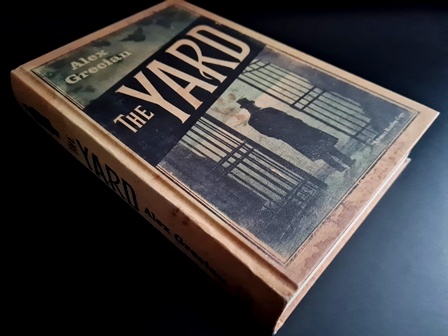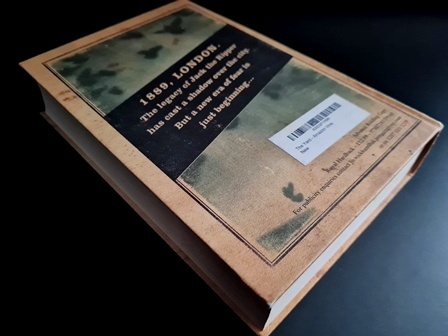
DLS Synopsis:
It’s 1889 in the troubled city of London, and its inhabitants are still reeling from the unforgotten scars left in the wake of Jack the Ripper’s horrific reign of terror. Trust in the Metropolitan Police Force is at a worrying low. And the streets of London remain a cesspit for the less desirable of people.
With murder allocated the most serious of crimes that can be committed, the police force’s commissioner, Colonel Sir Edward Bradford, decides that a new Murder Squad needs to be set up. Consisting of twelve experienced and dedicated detectives, these men work night and day to solve London’s most heinous of crimes.
One year on since the formation of Bradford’s Scotland Yard and Detective Inspector Walter Day has just transferred up from Devon to replace the well-respected and professionally admired Detective Inspector Adrian March. In fact, it was March who had recommended Day for the succeeding position. A recommendation that holds a vast amount of weight with the commissioner.
And now, just one week into his new position within Scotland Yard’s Murder Squad, and Day is confronted with the disturbing revelation that one of his fellow detectives, Inspector Christian Little, has been murdered whilst on duty. Furthermore, the body of the murdered officer is found to have been repeatedly stabbed, dismembered, bundled into a suitcase and then left at Euston Square Station with the corpse’s lips and eyes sewn shut.
Being the first detective on the scene, and along with his personal recommendation from D.I. Adrian March, Day is assigned the case by the commissioner. Instantly there is a deep worry that Jack the Ripper has returned to the streets of London once again. A fear that Day doesn’t facilitate. There are too many differences here. This isn’t the work of Saucy Jack. But if that’s the case, then perhaps more worryingly still, a new breed of killer seems to be on the rise.
Day is joined by the forensic pathologist, Doctor Bernard Kingsley, in piecing together any leads they have in finding Little’s killer. Together the two men must use their wit and judgement alongside testing out new methods of scientific-evidence-finding which are still only in there very infancy.
However, as the investigation continues, more murders begin to crop up around the streets of London. Bearded men are being targeted; their throats cut and their beards shaven clean off. The crimes seem vastly different to those of Little’s murder. But is it possible that two demented killers could be on the loose in the city at the very same time? Whatever the truth behind the growing list of murders is, there’s no denying the fact that London is once again in the grip of a whole new murderous madness…
DLS Review:
It must be said that Grecian’s ‘The Yard’ is certainly an entertaining read. Indeed, the novel has many positive points to it, but the sheer entertainment value is definitely the most prominent. It’s an easy read and one that successfully keeps the reader thoroughly glued to the page. Okay, so there’s no real mystery involved, or much in the way of actual suspense, but it has a raw energy to it that keeps the momentum and enjoyment of the novel going strong.
Although the synopsis and indeed the first chapter of the book seem to be geared up for a Victorian set murder mystery, quite soon into the book Grecian gives up any remote chance of a puzzling mystery and instead focuses on a periodically set serial killer thriller. This is not a bad thing by any means. It’s merely a different direction from what is perhaps expected.
The Dickens-esque Victorian setting (nicely post Jack the Ripper) forms a backdrop bursting with gritty potential. Indeed, it’s this periodical setting and all the murky aspects that go along with it, that really make the book. From his descriptions of the over-crowded streets, to the dark and dingy backstreets, to the crime, prostitution and almost universal cutthroat dog-eat-dog attitude; Grecian draws upon a wealth of dreary Victorian London aspects to achieve a vivid description of this painfully tough existence.
However, it’s nevertheless quite tricky to get completely submerged in the tale most notably due to the author’s constant faux-pas where it comes to the use of dialogue. Instead of a nineteenth century vocabulary, Grecian has instead adopted a more modern-day twang for each of the characters; slipping in casual Americanisms without much thought for really setting the periodical scene.
Along with this slight annoyance is the use of barely formed stock characters to merely thicken-out the expanding storyline. Indeed, characterisation is perhaps one of the most hit-and-miss aspects of the whole novel. D.I. Walter Day, Doctor Bernard Kingsely and Constable Nevil Hammersmith are each fleshed-out quite substantially; with their own intricately woven backstories that tells of who they are and their base motivations. Outside of these three characters, very little time is spent on developing on the characterisation of any of the other, quite numerous, players in the plot(s).
Having Inspector Christian Little’s killer revealed to the reader quite early on, Grecian utilises a first-person-perspective from behind the killer’s eyes, making the change in perspective instantly obvious by the use of default italics throughout the relevant chapters. Although somewhat surprising in its early unveiling, Grecian does quickly turn up the heat with the injection of a second set of murders, alongside an additional ‘uncaring-chimney-sweep-homicide’ subplot.
The use of badly treated children and the abduction of youngsters for the use in chimney-sweeping have a strange parallel running role within this somewhat meandering tale. Grecian plays with a handful of slightly related subplots that never really find a deliberate place with each other making the overall impression of the storyline verging on mildly confused.
The use of real-to-life characters, such as Sir Edward Bradford makes for a slight interest value – although only so much as for a vague name-dropping and little else. However, the inclusion of a homeless vagrant named after the well-known journalist and social researcher, Henry Mayhew, who would have died just two years prior to the time in which the tale is set, is a little mystifying to say the least (unless there’s an aspect to the novel that has simply gone clean over this reviewer’s head).
The novel ends in a drawn-out and decidedly twee fashion, with almost every character sitting smugly with an all-too-contrived happy ending.
However, by far the strongest aspect of the novel was the insertion of forensic science in its absolute infancy. Indeed, Grecian charts the very first few apprehensive steps of such practices as fingerprint analysis and fibre-testing, as an all important role within the developing storyline.
The novel runs for a total of 523 pages.

© DLS Reviews








